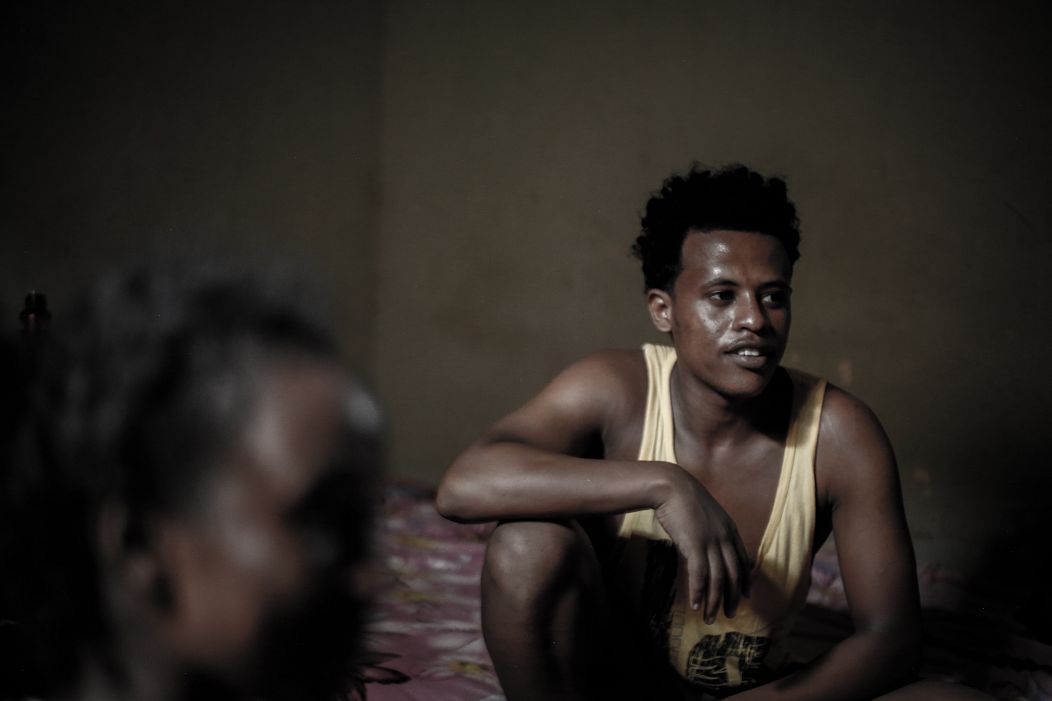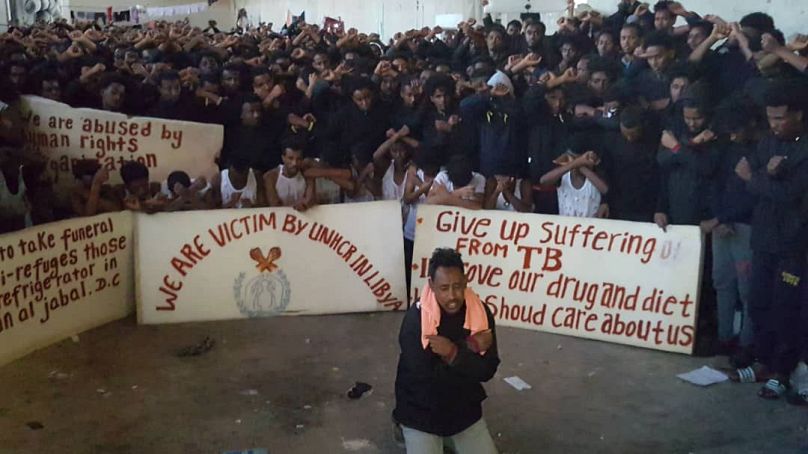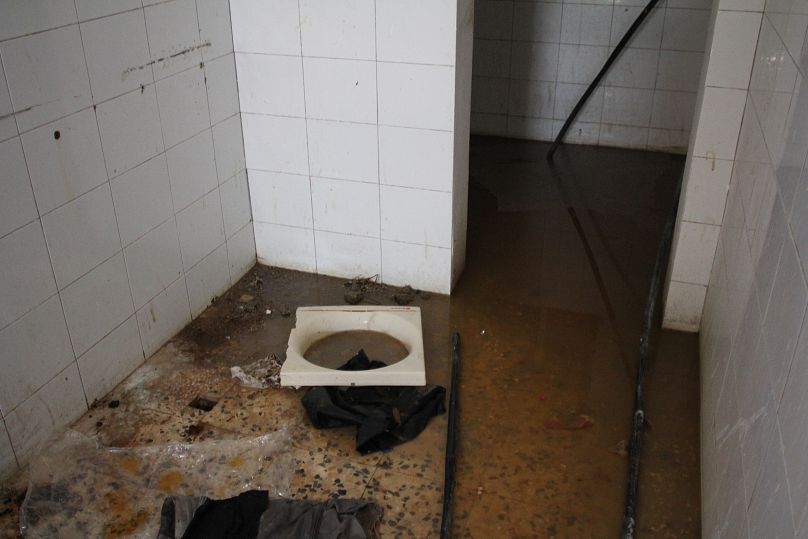UNHCR in Libya Part 2: Migrants in detention centres: 'Why does UNHCR want to keep us in prison?'
The UN agency has been accused of being a “fig leaf” for the policy of externalisation of EU borders; critics argue that UNHCR action is Libya is uneffective. We asked migrants held in detention centres their opinion.
In this, the second part of our four-part investigation into the UNHCR's operation in Libya, we talk to those migrants actually involved in the registration and detainment process. They tell Euronews their stories.
Despite increased EU funding to the Libyan coastguard, and an Italian memorandum of understanding with the DCIM (the body responsible for running migrant detention centres) no effective provision has been made by the EU to implement migrants' human rights and living conditions in Libya.
The migrant experience in the embattled North African nation is deteriorating. Many people in that position who spoke to Euronews have reported abuses after being thrown into detention centres with the hope of being registered by UNHCR. Testimonies include instances of torture, rape and extortion at the hands of local militias and when this leads to an attempt to cross the Mediterranean sea, reports also detail how they have been intercepted by the Libyan coastguards and automatically re-incarcerated into the detention centres.
“It has become an infinite, terrible circle from which there is no way out”, Julien Raickman, head of the MSF-France’s Libyan operation, told The Times.
UNHCR's main mission in Libya is to register migrants and find a solution to get them out of the country. However, as Raickman adds, “the resettlement procedure is totally blocked”.
As seen in part 1 of this investigation ➡️ SEE PART 1 the UN agency has been accused of being a “fig leaf” for the policy of externalisation of EU borders; more succinctly, the assertion is that UNHCR action is Libya is ineffective.
The body, headed by Filippo Grandi, repeatedly and urgently appealed to Europe to evacuate all refugees and dismantle the centres but blames its inefficiency on the difficulty of getting access to the facilities - an assertion that is challenged by the militias running the detention centres. At this stage, it is not clear what level of access UNHCR really has on each, individual centre.
As an unspecific response, UNHCR's Charlie Yaxley told Euronews: "The work we are able to carry out in detention centres is limited, as these are run by the Libyan authorities. Our access is restricted and we are limited to carrying out registration, protection assessments, medical referrals/treatment and providing basic relief items."
From the other side, Libyan authorities complain about the efficiency of UNHCR work in a country where they have to operate without a legal status or MOU.
“Some Ethiopian and Somali people in this centre [Tarik Sika, controlled by a pro-government militia] remained for two years here. After a period of 1-2 years, UNHCR informs that you are refused and not allowed to be resettled”, Captain Abdelnaser Ezam, vice president of Tripoli’s branch of the Ministry of the Interior, Government of National Accord (GNA) tells Euronews.
“During the last period, we had a Somali person waiting for two years here. Then, the employers of UNHCR came and informed him that he refused to be resettled. The result: he suicided by burning himself and died after 2 days in the intensive care in the hospital. This is the result of depression hit the immigrants because the immigrants believe that when they register for UNHCR and make interview, directly he will be accepted and have the resettlement”. The Somali migrant was called Abdulaziz, he was 28 when he died, in October 2018. He entered the centre nine months earlier.
Euronews followed testimonies across four detention centres:
- Qasr Bin Gashir
- Zintan
- Az-Zāwiyah
- Abu Salim
We wanted to discover and detail how a combination of inefficiency and bad management by UNHCR appears to perpetuate the very system that is under scrutiny in this series.
Back in April, a shooting at Qasr bin Ghashir centre, on the outskirts of Tripoli, caused several deaths and injured at least 12 people, according to MSF. It was the same episode for which UNHCR sent out a press release arguing that “gunshots were reported to have been fired in the air” and “there were no bullet wounds” ➡️ SEE PART 1; a version overturned by evidence found by MSF and Amnesty International. Prior to that episode, a source tells Euronews, migrants were left starving for two weeks and UNHCR offered them resettlement in Zintan, known to refugees as one of the worst facilities in Libya.
In Zintan, conditions are desperate: At one point during the Summer of 2019, 700 human beings were crammed on top of each other, starving. Twenty-two have died of TB and hunger since September 2018. 120 minors are reportedly at this facility.
UNHCR’s mandate does not include providing food and water for asylum-seekers and refugees, but their doctors had access to the centre as confirmed to Euronews by local authorities. Food supply is under the control of the Libyan Directorate for Combatting Illegal Migration (DCIM) but severe delays are reported in their payment to catering companies, thus resulting in service disruption.
The UN High Commissioner for Human Rights expressed concern for the “inhuman and degrading” conditions in which these refugees are held, “as well as ongoing reports of disappearances and human trafficking”.
During one of the many protests in the Zintan hangar, migrants held banners reading: “We are victims by UNHCR in Libya” and “We are abused by human rights organisation”. Their struggle is visible in social media images leaked by journalists such as Sally Hayden and reported by media including AP and NGOs such as MSF.
One migrant detained in Zintan told Euronews:
The UN agency for refugees “interviewed only 39 of these starving 650... in Zintan in June. Two days ago, only 27 of them were fingerprinted for evacuation”` tweeted human right lawyer Giulia Tranchina.
Having rejected the Zintan option after the shooting in Qasr bin Ghashir, migrants were finally resettled in the Az-Zāwiyah centre. Some others fled: among them a migrant with his pregnant wife. We will talk about their fate shortly.
Back to the Az-Zāwiyah centre. This specific facility is run by a militia sanctioned by the UN for human trafficking. One migrant told Euronews that UNHCR staff member called Waleed supports the resident militia:
This claim pertaining to a proximal relationship between the UNHCR representative and a senior militia member involved in the running of the centre is also referenced in an article by the Israeli news outlet, Haaretz. Here, Waleed is quoted referring to the camp manager as a 'cousin'. According to a migrant Euronews interviewed, this kind of scenario also played out at Abu Salim detention centre, near the front line: “The UNHCR guy never speaks with refugees and is friends with local police”. He also said the last time the UN agency came to register someone “was 6 months ago”.
We asked UNHCR spokespersons about the allegations pertaining to Osama and Waleed, but this specific point was not addressed by their response to us.
A source inside the Az-Zāwiyah centre tells us Osama and his men shot at migrants who refused to follow traffickers to whom they had been sold. “Several times there have been gunshots since we got here. Twice when the prisoners made attempts to escape, and about four were shot in their legs and two were shot dead”.
Thus, in both centres where the UNHCR operated, Qasr bin Ghashir and Az-Zāwiyah, migrants were fired at.
One migrant from Guinea, Moussa (not his real name), says he was shot twice in the ankles at Az-Zāwiyah. He says he ended up there after three different attempts to cross the Mediterranean, and four subsequent extortion attempts to be freed. In the prisons he visited, he claims to have been repeatedly tortured. Once intercepted by the Az-Zāwiyah coast guard unit, connected to the Osama gang, Moussa was brought to the centre “and we stayed two days without food”, he tells Euronews_._ A revolt broke out among refugees and was sedated with gunshots: “A Sudanese next to me was hit in the guts and died on the spot. His body was thrown in the desert”.
Later on, Osama reportedly told a seriously wounded Moussa to contact a guy called “Mohamed”, who set the price for his fourth attempt to cross the Mediterranean: 3,000 dinars (around 2,000 euros). Moussa was finally saved at sea by the Open Arms vessel and is now safe in Italy.
Moussa was luckier than the migrant who managed to run away from the shooting at Qasr bin Ghashir with his pregnant wife. We will call them Mohamad and Aya.
Immediately after 325 refugees were transferred from there to Az-Zāwiyah detention centre, UNHCR evacuated more than 140 migrants out of Libya. When the names of Mohamad and Aya were called, they were not there and missed their chance to leave the country for a safer one. Ever since then, they are stranded in the streets of Tripoli with their new-born baby like the majority of asylum-seekers in Libya. “We fear going out”, they say to Euronews referring to the dangers of having no protection in the Libyan capital. “We escaped from the detention centre because the military came to attack us”.
Now Mohamad cannot enter the UNHCR's Gathering and Departure Facility (GDF) in Tripoli as his case is not among those entitled to evacuation. By running away from the bullets, they lost their right to get out of Libya. They had repeatedly tried to contact UNHCR offices both in Tripoli and Geneva, both had received no answers. “I am going to the office to ask about my case and some assistance like food and shelter, still nobody helping me”.
A UNHCR officer explained to Euronews that resettlement is prioritised according to vulnerability because of the lack of available places, and - crucially - one key element of this is physically being in a detention centre as this is where conditions are at their worst. People who escape from the centre don’t realise that this affects their prioritisation for resettlement.
It can be read this way: if refugees want to have any chance of being resettled, they need to stay in detention centres and wait. No matter what. This is discussed further in ➡️ SEE PART 3.














